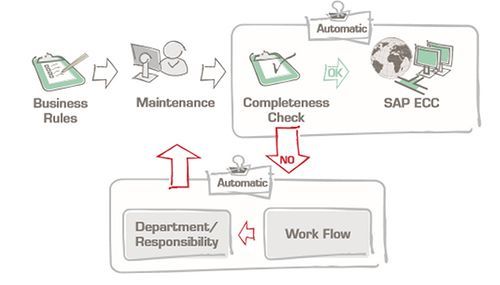Master Data: Everybody needs it, nobody wants to handle it!

Would you feel comfortable working in a building that looked like this? Probably not!  Let’s set this picture aside for a minute and talk about Master Data.
Let’s set this picture aside for a minute and talk about Master Data.
Companies who have implemented or are in the process of implementing a Tier 1 ERP Software package, such as SAP ERP, often spend a substantial amount of time and emphasis on designing transactional business process, key performance indicators (KPIs), and high power analytical tools. In today’s environment, companies are looking to technology—and specifically their ERP systems—to help identify business opportunities to accelerate growth. They need to grow market share, expand to new markets, spot vertical trends and outperform the competition.
This said, less resources are typically allocated to the foundation of these dynamic processes and reporting. Master Data. Poor data quality is often the root cause for unreliable business processes and misleading analytics.
SAP enterprise software provides an unique, integrated data model which allows flexibility and consolidation of multiple companies across geographical boundaries within a single system. We’ve discovered that most of our customers find the Master Data maintenance process to be complex, labor intensive, and time consuming to manage. These symptoms often impact the data quality and ultimately lead to governance procedure issues. Poor Master Data quality and undefined governance are indifferent to your industry, line of business, or what ERP software package you use. It affects us all.
Master Data is used, modified, and updated simultaneously by multiple users for various purposes within an organization. The probability of input errors and inaccurate data grows exponentially as each new user, product, or product line is introduced to the SAP system. The more integrated the SAP system landscape, the quicker errors will widen, multiply, and compound. This requires rigorous and time consuming investigations and corrective actions. Unlike transactional data, Master Data has a longer shelf-life and is used to support complex business processes, requiring continuous governance and maintenance throughout the entire lifecycle.
To fully realize Master Data governance success, you must first define the policies, processes and standards. In order to establish these operational policies while ensuring quality integrity, the overall data governance strategy and related tools must be defined at the implementation phase. Doing this will help protect the quality standards in a user-friendly manner. The solution tool that you select should provide a scalable framework to easily adapt to new needs as your business grows. It’s important to consider these points when running SAP ERP software.
Assess the state of your Master Data foundation with these questions:
Are your Master Data creation and maintenance rules documented and utilized in the SAP system where maintenance actually takes place? Are they aligned across all business units? Or are they scattered around your company via excel sheets, random documents, or tucked away in people’s minds?
Do you ensure that only allowed fields are changed in accordance with the rules? Are you confident that the Data is validated and approved by the correct departments? Or do you trust that manual errors is something that only takes place in your competitor’s organization?
Are you able to document which Master Data fields are changed and why?
If you cannot answer “YES” to all of the above questions, and you don’t want to go to work in a building with a shaky and unstable foundation, then NTT DATA Business Solutions and its solution, it.MDS (Master Data Simplified), can help by:
- Providing out-of-the-box functionality and features that ease the maintenance of master data through business rules, automated completeness checks with SAP® ERP, and automated workflows for updates and changes.
- Its profile-based functionality creates dependencies between master data objects and fields, and provides central rule maintenance and decentralized master data maintenance. The workflow supports approval of new master data entries and changes. In other words, master data becomes closely linked with business, while business rules and workflows support governance.
ROI for it.mds
An example of the return on investment for it.mds can be found in the case study “Nilfisk-Advance Eliminates the Need for Millions of Manual Keystrokes.” In this case study, Nilfisk-Advance explains how they were able to reduce the number of entries required for one material number in 61 locations from 3,615 to 199—ultimately saving thousands of hours each year of manual, non-value added, error-prone activities.
Want to learn more about how to manage your Master Data?
Register for our webinar and it.mds demonstration: Webinar – “Master Data Simplified – Styring af stamdata i én integreret løsning”.
For more information on it.mds, please visit the NTT DATA Business Solutions NTT DATA Business Solutions Addstore.